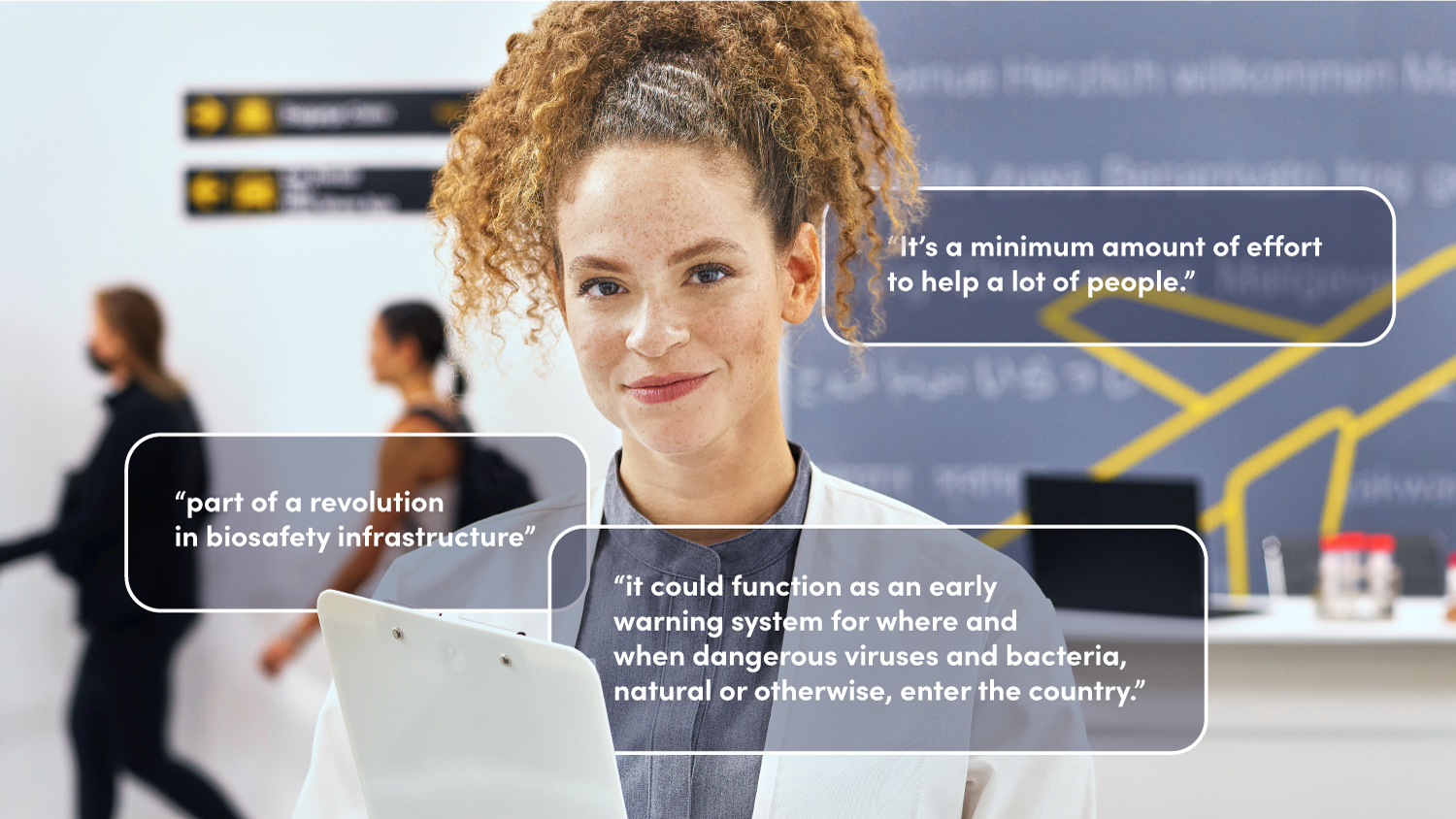In-airport monitoring reveals the pathogen risks that fly under the radar
January 20 2023

Have you been keeping up with the Traveler-Based Genomic Surveillance (TGS) for SARS-CoV-2 news? The program, which monitors for COVID-19 variants at U.S. airports, has really taken off in the press of late.
Take a look at what others have to say about TGS:
“This is by no means a border-control program designed to find and isolate. This is a surveillance program [aimed at providing early warning].”
Dr. Cindy Friedman, Chief of CDC Travelers’ Health Branch
LA Times
TGS works like an early warning radar for pathogens. Taking samples from asymptomatic international travelers provides a dynamic view of what’s entering the country. In the hands of public health experts, the data can be used to forecast potential spread, characterize variants, and respond to emerging risks.
“[The program] is seen by administration officials and public health experts as part of a revolution in biosafety infrastructure — and a critical plank of national security in the post-pandemic era. As it expands geographically and sets its sights on new pathogens, it could function as an early warning system for where and when dangerous viruses and bacteria, natural or otherwise, enter the country.”
Krista Mahr
Politico
Humans’ tendency to travel makes it easy for pathogens to hitch rides with unwitting passengers and spread globally. Certain policies, like the recent announcement requiring travelers from China to produce a negative COVID-19 test prior to arrival in the U.S., focus on individual cases. TGS is about capturing the big picture (the 30,000-foot view, if you will).
“We want to know when a new variant either is arriving or rising quickly, and these are the tools that will help answer those questions. Otherwise, we’re just waiting for those things to show up in cities.”
Tom Inglesby, Director of the Johns Hopkins Center for Health Security at the Bloomberg School of Public Health
Politico
Traditional genomic surveillance relies on cases being identified at hospitals or clinical laboratories. TGS offers a rare opportunity to study pathogens as they arrive stateside. Learning how new variants behave before they become dominant buys precious time for experts to plan countermeasures that help mitigate public health impacts.
“A supercharged coronavirus variant called XBB.1.5 is spreading quickly in the U.S. – and it’s aggressive enough that scientists have nicknamed it the ‘kraken’ variant.”
Hilary Brueck
INSIDER
Currently, the focus is on XBB.1.5, affectionately dubbed the “kraken” by some scientists. XBB.1.5’s prevalence has been doubling week over week, according to our experts. As Andy Rothstein (one of our computational biologists leading the TGS program) explained to INSIDER, XBB.1.5 is the most contagious and immune-evasive Omicron variant in circulation. A mutation allows the virus to attach to ACE2 receptors more easily, fueling its aggressive growth. Dr. Friedman said it best in this NPR article, “These viruses are smart—they can mutate. And we want to be ahead of the game and early in our detection of new variants.”
“It’s a minimum amount of effort to help a lot of people.”
S. Chandra, participating traveler
AP News
Chandra’s story is one of many—more than 80,000, actually. Each volunteer is a unique reminder that, three years into COVID-19, the only way through this is with everyone pitching in. The ease of volunteering a sample has made TGS a mainstay at seven international airports in the U.S., with potential for more locations in the future. As the program expands, we hope more travelers take the time to earn their “TGS wings” and help us characterize variants of concern.
“COVID-19 wastewater surveillance has shown to be a valuable tool and airplane wastewater surveillance could potentially be an option.”
Kristen Nordlund, CDC spokesperson
Reuters
One tactic that could expand TGS’s risk insights is testing wastewater from aircrafts on international flights. We are working to incorporate passive monitoring alongside pooled PCR surveillance testing to extend the runway for data collection.
We are also adding monitoring capabilities for even more pathogens, including monitoring for influenza strains, and more additions are on the way. Establishing TGS as a multi-pathogen early warning radar means, if and when COVID-19 is behind us, we’ll have the tools in place to be ready for what’s next. As Matt McKnight described to Politico, “You want to be able to detect genetic variants of COVID-19. You want to be able to detect genetic variants of other threatening pathogens that might show up, known and unknown. And you want to have the capability to look for mistakenly released genetically engineered organisms…That’s the dream of biosecurity infrastructure. And it’s totally doable.”
Every warning by land, sea, and air
No matter how they arrive, travelers are like roving sentinels for detecting pathogens as they spread to new places. Adding new airports and expanding the network to include seaports, border crossings, and other ports of entry will be pivotal to a global early warning system. For more on using TGS to proactively fight infectious disease, check out our Airports & Travel page.